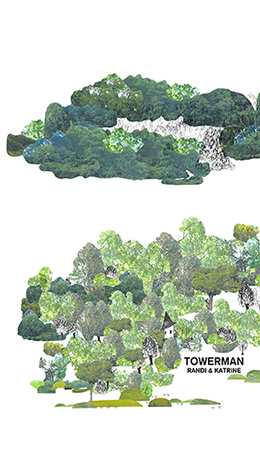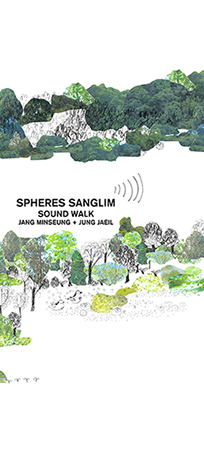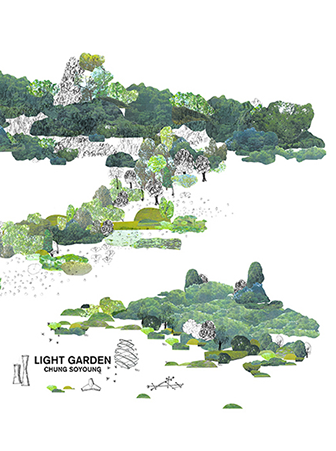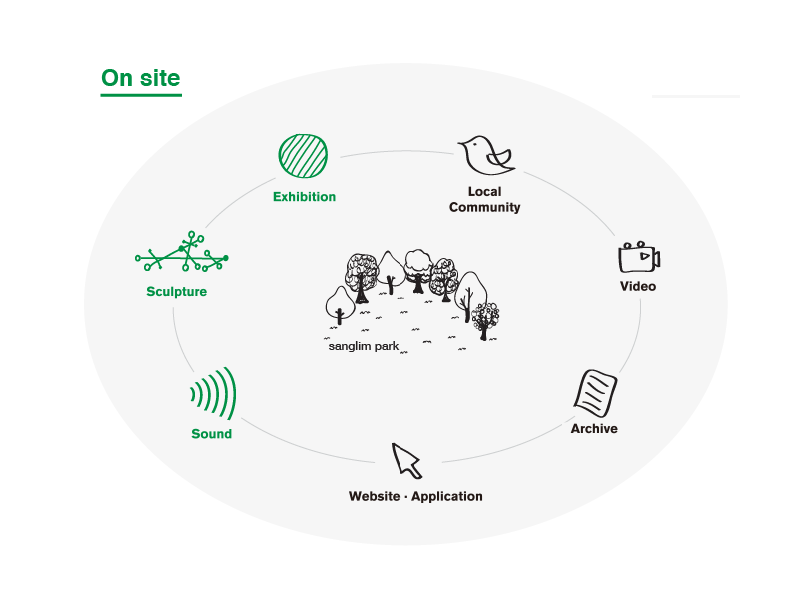


|
|
||
|
<ROUND PROJECT> is a public art project in Hamyang, which aims through sound, video works and outdoor sculptures to connect Sanglim Park, Yunji Park(Lotus Garden) and Gowoon Park into a setting of organic integration. By understanding the forest as the centre of Sanglim Park, the project is curated to focus on the visitor’s holistic experience with the art works, which embraces the surrounding areas into the visitors daily life.
|
||
|
|
||
|
On Round Project It is undoubtable that the main interest of the artistic and cultural community is focused on the term interdisciplinary art. Rather than being a sub-genre within the fine art categories, interdisciplinary art is a sort of attitude or method of approach taken by an artist or curator through their artistic practices in general. However, we often encounter cases where interdisciplinary art is treated rather exaggeratedly as a distinct field of art. In other cases the term is used as a tag name without any great relevance. Prior to initiating the public art project at the city of Hamyang, and long before considering which artists to work with, which work to show or deciding on a specific art genre, the first step as a curator of the project was to come up with an attitude or perspective. The main point was to create an idea of how to view this specific park and the pilot project on public art by the Korean Arts Council. I have frequently visited Hamyang, a small town in the South-West of Korea, where I took walks through the Sanglim forest in the daytime and nighttime. Through discussions with the people at the Department of Culture and Tourism in Hamyang (important partners whom I later relied on the most), I have learned about the history of the Sanglim forest and its current state as well as their future planning. Thus, I have had a lively experience and gained a deep understanding on Sanglim Park through this process. Finally, I found the main orientation of the Round Project in the idea of a ‘holistic experience’, which includes synesthetic elements and factors that relate to various levels of time through direct and indirect experience and the understanding of the forest. Instead of rejecting an approach of certain art genres (or mixing the genres deliberately to give them the title of ‘interdisciplinary’ and classifying them into a sub genre) and rather than designating and forcing a certain action, there are two different levels to this orientation. I will discuss these two levels down below. First, there is the level of direct experience: a direct viewing, listening and walking through the diverse elements, wind, sound, smell, and light, of the forest‘s environment. Second, without such physical experience enabled by an actual visit to the Sanglim forest, one can experience the forest indirectly through the new website which open for the Round Project, and provide us with a textual, visual and audible experience. The experience of the latter allows us to overcome the limits of physical time and spatial movement. It reflects the curatorial intent of providing a potential experience of the forest rather than a physical one. It creates a splendid artistic experience of having memories of the future. According to the curatorial intent, on one side the indirect experience through the Web, a smart phone application or a physical experience and, on the other side an actual visit overlap each other and create a new level of memory. Furthermore, this new level of experience through the Web or Apps creates an expectation of interest and the possibility that Sanglim Park, the site of the Round Project in Hamyang, might go viral. Another important aspect of this project is the ‘versus’ spirit. Versus signifies the natural revelation of mutual differences through contrast and comparison between more than one phenomenon, or the discovery of the overlapping of the identical and the different through comparison. When assuming that nature’s beauty embraces the ugly, and that the continuous includes the temporary, all kinds of relatively different opinions and perspectives are revealed. Instead of erecting a single solid monument or having a declarative attitude, the curatorial intent here is to leave part of the process open and invite new possibilities to pass by constantly. In the center of Sanglim Park, you can find the forest. No wonderful artistic curation can substitute for this fact. Therefore, the various participants who collaborated for the Round Project(Arts Council Korea, local autonomous parties, curator, artists, etc.) had to be in the same league of understanding. |
‘Forest’ and ‘art’ are the central points of this project, despite respectively different objectives and perspectives. An active involvement of the local community is to be realized by the artist duo Jang Minseung and Jung Jaeil. Yet the forest is still the center and the project rejects the idea of a fragmented program of participation, which has the potential to objectify the local community. Minseung and Jaeil’s ‘Sound Walk(Spheres) Project’(music and video work) is a collaboration with the Orchestra of Hamyang, which is composed of children youth and adults. The orchestra plays the music, of which the original score was composed with the theme of the four seasons of Sanglim forest, at various places in the forest. The scenes are then filmed on video and the video and music will be shared through the Web. Next to this there will be the pleasant occasion of experiencing another level of synesthesia, which is provided by an application based on GPS. While walking through the woods, music that has been played previously will be re-played automatically in specific places. Even though there is no useful or convenient facility around and the sculpture work does not necessarily please the eyes of the viewers, I believe this project will certainly become a local heritage that using the common language of ‘music’ transcends time and space. I truly hope that for both the Hamyang Orchestra members who have participated in the creation of the work and for all the citizens of Hamyang, this intangible asset called musing will last for a long time. For those who have not left their hometown, the music could become their common experience, and for those who have left, it shall be the link of memory between the homeland and oneself. Despite all of its convenient facilities, the cultural complex that opened recently at the entrance of Sanglim forest, and the newly developed park nearby are, compared to the forest, not frequented enough. The overwhelming beauty created simply with art works by the piles of layered time of Sanglim forest, must surely be difficult to approach. However, the notion of ‘mirror image’ introduces a different form of ‘forest’. ‘Light’ was introduced as an element like the mirror image of the forest and composed into a series of sculpture works. Despite the inherent limits of outdoor sculpture works, Chung Soyoung’s work will become a little twinkle of everyday life for Hamyang citizens. The work will be placed at Gowoon Park, and will suggest that the forest has become a beautiful piece of sculpture itself in the context of daily life. (The operational method of the work is borrowed from the mechanism of a kaleidoscope, which collects as much light as possible from the forest).These sculptures are like a bench on which people could take a short rest and view the light that is attracted by the kaleidoscope to see the piece of sky visible through the periscope’s lens. In this way the sculptures have the potential to be a wonderful playground for children. Art, changing its form with flexibility, has a huge potential for new possibilities that can appear during the process of creation. However, due to administrative reasons a publically funded project lacks such flexibility, which truly is a pity. If a longer term of preparation was allowed for the curation and execution of the major works, there could have been more workshop programs and events with the participation of Korean and international artists. This would allow a more flexible approach to share the joy with the community. Additionally, it would be wonderful if we could have a kind of performance with music as medium in the special environment of the forest. Even though it might be difficult to realize these willful ideas within this year, the temporary intervention in the space still allows us for the will to prolong the time and to wander about in the beautiful forest. |
